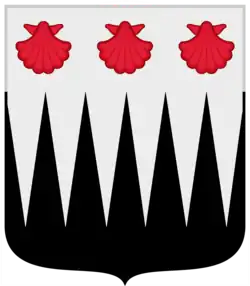Ruffo di Calabria
| House of Ruffo di Calabria | |
|---|---|
 | |
| Country | |
| Founded | 10th century (origin) 1578 (princely title) |
| Founder | Pietro I, Count of Catanzaro Fabrizio (VIII Count of Sinopoli, I Prince of Scilla) |
| Titles | List
|
| Motto | Omnia bene ("Everything is good") |
| Cadet branches | Ruffo di Catanzaro Ruffo di Montalto Ruffo di Sinopoli Ruffo di Bagnaro (extinct) Ruffo della Scaletta Ruffo di Castelcicada (extinct) Ruffo de Laric (or de La Ric) (extinct) Roux de Lemanon Roux de Beauvezet (extinct) Ruffo de Bonneval de La Fare |
The Ruffo di Calabria[1] are one of the oldest and most illustrious families of the Italian nobility, already counted among the seven greatest noble houses of the Kingdom of Naples.[2]
Origins

Motto: Omnia bene.
Blazon: Troncato, cuneato d'argento e di nero, il capo caricato di tre conchiglie al naturale
The antiquity of the origins of the Magna Domus[3] of the Ruffo di Calabria has long been the subject of hagiographical and genealogical writings. In the second half of the 13th century, Simone da Lentini, Bishop of Syracuse, wrote: "Rufa nobilissima et vetustissima familia, tempore romanae reipublicae magnopere vixit et usque ad meum tempus potentissime vivit",[4] testifying to the family's prestige and longevity.
In the 17th century, Giovanni Fiore wrote in greater detail: "The Ruffo di Calabria are attributed with remote origins, as if their name derived from the Latin Rufo. Chroniclers reported that the Ruffo and the Giuliani were lords of vast territories, so much so that around the year 1000 'the Emperor of Constantinople, having allied himself with them, reconquered Apulia and Calabria'. Others consider them of Norman origin: Filippo and Errigo Ruffo, in the service of Robert Guiscard, occupied Terra d'Otranto and Basilicata."[5]
Historical sources unanimously attest that the Ruffo were already flourishing in Calabria before the year 1000. As for the alleged Roman origin and the fanciful genealogical reconstructions proposed, these can only be read as a sort of founding myth — a politically legitimising legend in whose construction the family, taking great pride in it over the following centuries, can hardly have been entirely uninvolved. Less implausible, as will be seen, is the hypothesis of a Byzantine origin, for which, however, the same considerations expressed for the Roman one apply; the hypothesis of a Norman origin, though still conjectural, appears to be the most plausible.
Roman hypothesis

According to this colourful but largely fanciful hypothesis, based solely on the similarity of names, the Ruffo were said to descend from the Gens Cornelia, and in particular from its consular branch, the Rufi. This line claimed kinship with Sulla, tracing its eponymous ancestor to a Cornelius Rufus who, according to the Sibylline Books, proposed the institution of the ludi apollinares.[6]
An obscure figure referred to as "Tamusio Tinga" even claimed that the family originated from Ascanio Silvio, son of Aeneas, through his third son Rufus.[7][8]
This supposed connection, along with the family's veneration of Saint Rufus of Capua — a 1st-century martyr and third bishop of Capua —[9] cannot be regarded as evidence of Roman origins or of an early conversion to Christianity.
Byzantine hypothesis
Like the previous one, this genealogical hypothesis is not supported by historical documentation and can be considered nothing more than a family vulgata. However, the presence at the imperial court of Byzantium of prominent figures — consuls and generals — bearing the surname Rufus is historically attested. Early hagiographers of the Ruffo family, though not particularly reliable, listed among their supposed ancestors:
- Marcus Antonius Rufus I (4th century), probably converted to Christianity, a general of Constantius Chlorus who fought alongside Constantine the Great against Maxentius at the Battle of the Milvian Bridge. In gratitude, Constantine was said to have made his family one of the most prominent in the newly refounded Constantinople.
- Lucius Rufus (son of the above, 4th century), an officer under Constantine II who died around 340 during the unsuccessful campaign against Constans.
- Lucius Antonius Rufus (5th century), a general of Valentinian III who fought against the Vandals under Genseric; the Roman army he possibly commanded was defeated in 431.
- Marcus Antonius Rufus II (late 7th century), a general who distinguished himself in Macedonia. Loyal to Emperor Justinian II, he was removed from office by the usurper Leontios and subsequently assassinated around 695.
According to family tradition, over the centuries the Ruffo became connected to the Byzantine imperial dynasties of the Heraclian, Isaurian, and Macedonian houses, which are said to have entrusted them with the governance of Calabria.[10]
Norman hypothesis
This is generally considered the most plausible theory.[11] Individuals bearing the surname Ruffus or Rufus are documented in the 11th and 12th centuries — the same period in which the Ruffo are first historically attested in Calabria — in England, Sicily, and southern Italy.
It should be noted, however, that this theory could coexist with the previous one, allowing for a possible Norman–Byzantine origin of the family, as Varangian and Norman mercenaries were present in Constantinople as early as the 9th century.[12]
Historical attestation
The earliest historical records of the Ruffo di Calabria date back to around the year 1000. In the Chronica Monasterii Casinensis by Leo of Ostia there is mention of the previously noted alliance between the Byzantine emperor and the Ruffo and Giuliani families to recover Calabria and Apulia for the Byzantines.[13]
About a century later, a Pietro Ruffo — said to have been born in 1118 — was created cardinal by Pope Gelasius II. In 1125, a Gervasio Ruffo was appointed strategoto of Messina[14] and, in 1146, was elevated by Roger II of Sicily to the rank of lord of Mizzillicar and Chabucas.[15]
A probable descendant, named Ruggero de Gervasio, was appointed vallectus camerae by Frederick II in 1223.[16] Around the same time, a Serio Ruffo, Grand Marshal of the kingdom, is recorded as having taken part in the escort of the emperor's body to Taranto.
Cadet branches

- Ruffo della Scaletta: branch originating from the Bagnara line in the 17th century with Antonio Ruffo (1610–1678); Princes of Scaletta, Princes of Floresta, Barons of Guidomandri, Monaco, Luponaro, San Giorgio, Cucco, Randé, Castellana and Fegotto; lords of Giampilieri, Molino and Altolia; noble patricians of Messina.
- Ruffo di Bagnara[17][18]: extinct branch originating from the Sinopoli line in the late 15th century with Esaù Ruffo; Barons of San Lucido; Dukes of Bagnara and Baranello; Princes of Sant’Antimo, Fiumara di Muro, and Motta San Giovanni; Marquesses of Guardia; Neapolitan patricians.
- Ruffo di Castelcicala[19]: branch from the Bagnara line in the 17th century with Fabrizio (1648–1720); Barons and later Princes of Castelcicala; Neapolitan patricians. This branch became extinct in the second half of the 19th century through the marriage of Giustina, daughter of Paolo, to Marquis Giuseppe Corio di Sacconago. Their daughter Paolina married Giuseppe Sallier de La Tour in 1893, who maritali nomine obtained the titles of Prince of Castelcicala and Duke of Calvello (Ministerial Decree, 20 October 1907).
- Ruffo de Laric or de La Ric (formerly Roux de Laric): extinct French branch originating from the Sinopoli line in the 14th century with Carlo Ruffo[20]; Counts of Laric; Marquesses of Courbons; Barons of Oze; Neapolitan patricians.
- Roux de Lamanon: French branch originating in the 15th century from the de Laric line; co-lords of Lamanon and Aurons.
- Roux de Beauvezet: extinct French branch originating in the 15th century from the de Laric line; lords of Beauvezet.
- Ruffo de Bonneval de La Fare (formerly Roux de Bonneval)[21]: French, later Belgian, branch originating from the Sinopoli line with Ruggero Ruffo[22] in the 14th century; Lords of Bonneval; Marquesses de La Fare; Neapolitan patricians.
See also
- Castello Ruffo di Scilla
- Castello Ruffo di Amendolea
- Castello Ruffo di Nicotera
- Palazzo Ruffo della Scaletta
References
- ^ "Famiglia Ruffo di Calabria". www.nobili-napoletani.it (in Italian). Retrieved 28 November 2021.
- ^ The "Serenissime Sette Grandi Case del Regno di Napoli" ("Most Serene Seven Great Houses of the Kingdom of Naples") included the Acquaviva, Celano, Evoli, Marzano, Molise, Ruffo, and Sanseverino families. When the Evoli, Marzano, and Molise families became extinct, they were replaced by the d'Aquino, del Balzo, and Piccolomini families. For further information, see: Archivio di Stato di Napoli – scheda famiglia Sanseverino Archived 24 December 2013 at the Wayback Machine; B. Filangieri di Candida Gonzaga, op. cit., ad voces; Spreti, op. cit., ad voces.
- ^ Meaning "The Great House", an honorific term probably adopted during the Spanish period, commonly used to refer to the Ruffo family (Imhoff, op. cit., p. 283).
- ^ Meaning "The most noble and ancient Ruffo family lived splendidly in the time of the Roman Republic and, until my own time, continues to live most magnificently" (quoted in Imhoff, op. cit., p. 283).
- ^ Fiore, op. cit., p. 603.
- ^ E che per tale ragione fu soprannominato Sibilla e fu il primo in seguito ad essere chiamato Silla per alterazione del nome (Sara Fattor, Scrittura Sibillina, I libri fatales della storia romana, Tesi di laurea, Trieste 2007, pp. 121–122, nota 326. Archived 6 March 2016 at the Wayback Machine)
- ^ Potrebbe, forse, trattarsi di Tanusius Geminus, storico citato da Svetonio di cui non ci è pervenuta l'opera; oppure, più probabilmente, di una falsa fonte citata in qualche testo antico alla maniera di Alfonso Ceccarelli.
- ^ Giovanni Ruffo, op. cit.
- ^ L'altare della cappella del palazzo Ruffo di Bagnara è a lui dedicato ed è pure ricordato nella chiesa di San Giuseppe dei Ruffi dove la Famiglia Ruffo di Bagnara deteneva un altare di patronato.
- ^ Non si dà conto, se non in nota, dei due matrimoni che, sempre secondo i genealogisti citati in bibliografia, avrebbero imparentato i Ruffo bizantini con due imperatori: nel IX secolo, Basil I is said to have married a certain Berenice Rufa, and in the 12th century, Andronikos I Komnenos a certain Yole, or Giovanna, daughter of Giovanni Fulcono Ruffo, governor of Macedonia.
- ^ Among those holding this view is Ernesto Pontieri (op. cit.); the Norman origins of the house were also discussed by the prelate Angelo Braschi — the future Pope Pius VI — when he was secretary to Cardinal Tommaso Ruffo.
- ^ Tramontana, op. cit., p. 91, note 25.
- ^ The MS. 276 (f. 310) of the Biblioteca Angelica in Rome also records an Ademaro Ruffo in 1046.
- ^ Arena, op. cit., tav. XXVII; Giovanni Ruffo (op. cit.) considers the related title of stratiote, by which Gervasio is described elsewhere, as proof of the family's Byzantine origin; see above.
- ^ The document is preserved in the Archivio di Stato di Napoli ("Fondo Ruffo di Scilla". Archived from the original on 13 April 2013. Retrieved 16 October 2022.); the two toponyms, likely of Arabic origin and located in the territory of Sciacca, have not been identified; according to Giovanni Ruffo (op. cit.), Gervasio here is referred to with the title of "stratiote".
- ^ The privilege, translated from Greek, is published in Paolucci (op. cit., p. 38).
- ^ Archivio di Stato di Napoli – Scheda Storica sulla famiglia Ruffo di Bagnara Archived 14 July 2014 at the Wayback Machine
- ^ "Famiglia Ruffo". www.nobili-napoletani.it (in Italian). Retrieved 12 October 2022.
- ^ "Famiglia Ruffo-Castelcicala". www.nobili-napoletani.it (in Italian). Retrieved 12 October 2022.
- ^ Involved in the murder of Andrew, Duke of Calabria, he and his brother Ruggero fled to Provence with Queen Joanna I of Naples. Their descendants were naturalised as French and the surname modified to Roux, but in 1775 they were authorised to resume the original Italian form.
- ^ In 1814 they obtained royal permission to restore the surname from the French "Roux" to the original Italian form; recognised by the Belgian nobility in 1902 with letters patent from Leopold II, the surname was modified to Ruffo de Bonneval de La Fare des Comtes de Sinopoli de Calabre.
- ^ In Provence with his brother Carlo around 1347, he served as chamberlain to Queen Joanna I of Naples.